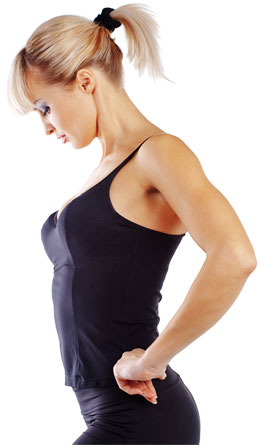- Like
- SHARE
- Digg
- Del
- Tumblr
- VKontakte
- Flattr
- Buffer
- Love This
- Save
- Odnoklassniki
- Meneame
- Blogger
- Amazon
- Yahoo Mail
- Gmail
- AOL
- Newsvine
- HackerNews
- Evernote
- MySpace
- Mail.ru
- Viadeo
- Line
- Comments
- Yummly
- SMS
- Viber
- Telegram
- JOIN
- Skype
- Facebook Messenger
- Kakao
- LiveJournal
- Yammer
- Edgar
- Fintel
- Mix
- Instapaper
- Copy Link
 A Lesson in Exercise Mythology
A Lesson in Exercise Mythology
In the fitness industry, there is a lot of misinformation out there that unfortunately holds a lot of us back or drastically slows the progress towards our goals.
It’s too bad that this is the case for many of us already have a hard enough time achieving our health and fitness goals. Whether it’s finding the time to go to the gym or preparing a healthy meal at home, the list of reasons many of us struggle to reach our goals are plenty.
On the other hand, there is still a lot of legitimate information out there that can help boost your fitness progress and take you towards your goals with speed and confidence. The goal of this article is to do just that.
I’m going to shed some light on what I believe are five of the biggest fitness myths floating around the industry. I hope you find this information beneficial on your fitness journey and I wish you the best of luck achieving your goals.
The Top 5 Fitness Myths
#5. Low Intensity Cardio Burns Fat Best
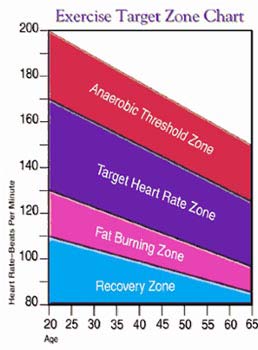 “I’m not running on the treadmill because I want to be in the fat burning zone.”
“I’m not running on the treadmill because I want to be in the fat burning zone.”
In gyms throughout the world there are people who think they are doing well by following the instructions on the cardio machine.
The chart shown on cardio machines tells you to keep your heart rate low and you’re in the fat burning zone!
Naturally you’re on the evil treadmill to burn fat so you keep your heart rate there.
The fact is fat burning depends on your caloric balance. This means you must burn more calories than you consume throughout the week to burn fat.
Well, spending 30 minutes with your heart rate at 120 beats per minute in the “fat burning zone” burns 150 calories while 30 minutes in your target heart rate zone at 170 beats per minute burns 300 calories.
Using simple math, which is better for fat burning? Not the fat burning zone! Myth Busted!
How This Fitness Myth Got Started
The chart you see on every cardio machine is actually true, for a lab test! At a low heart rate your body is burning the largest portion of fat for energy as opposed to carbohydrates and protein but the fuel used for an exercise session is insignificant to your body as a whole from week to week.
The notable exception which also feeds this fitness myth are bodybuilders. Bodybuilders, especially in competition preparation have extremely low body fat. In their case, higher intensity cardio exercise could actually break down their muscle because of lack of storage fat which to a competitive bodybuilder is a no no, thus bodybuilders with very low body fat should stay in the fat burning zone.
Further Reading: https://www.askthetrainer.com/best-cardio-exercise/
#4. Longer Workouts = Better Workouts
 “I can’t see why I’m not getting results, I workout for 3 hours a day, 5 days a week?”
“I can’t see why I’m not getting results, I workout for 3 hours a day, 5 days a week?”
With most goals exercise quality is more important than quantity. Smart exercise will always take precedent over long exercise.
Each workout has 2 primary variables: intensity and duration. The intensity is basically how hard you work out, while frequency is how long you work out.
In weight training and cardio results come with monitoring and improving intensity. Therefore you should try to workout at a certain intensity so the duration is limited.
If you do not limit the duration of your exercise session your intensity was not likely sufficient for the time you exercised.
Not controlling your workout intensity and spending too much time in the gym is actually bad for your body because your body will produce excess stress hormones which will hinder the recovery process.
How This Myth got Started
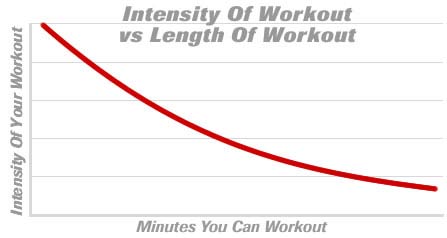 Exercise and the results which accompany it are often addicting. The human being only naturally begins to think that if working out for 60 minutes helped lose 20 pounds, then working out for 120 minutes must be even better, which is not true and a fitness myth which causes many people to spend counterproductive time in the gym.
Exercise and the results which accompany it are often addicting. The human being only naturally begins to think that if working out for 60 minutes helped lose 20 pounds, then working out for 120 minutes must be even better, which is not true and a fitness myth which causes many people to spend counterproductive time in the gym.
Further Reading: https://www.askthetrainer.com/sets-and-reps/
#3. Muscle Soreness = Results
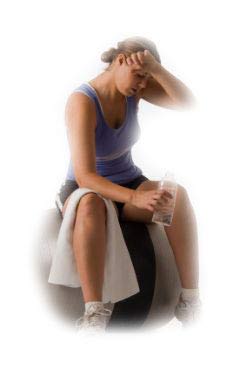 “I thought I got a great workout yesterday but I’m not sore at all?”
“I thought I got a great workout yesterday but I’m not sore at all?”
Many people judge their previous workout by muscle soreness which follows and equate it with having a good workout.
Delayed Onset Muscle Soreness (DOMS) usually occurs within 24-48 hours after a workout and depends on numerous factors including, state of training, length of workout, phase of training, amount of rest and nutrition.
Muscle soreness is due to inflammation and micro-damage of muscle cells. If you are eating massive amounts of calories theoretically this is a positive because it will help in muscle growth.
People with weight loss/toning goals should take note that excess muscle soreness most likely means they are overtraining, especially with a hypo-caloric diet.
The less sore you are after a workout, the more often you can workout which is better for boosting metabolism. You don’t have to feel like you were beat down by a professional MMA fighter after your workouts to get quality results.
How This Myth got Started
When people go from being sedentary to working out they often experience muscle soreness along with the quick results they get from increasing their activity levels from sedentary. They associate the muscle soreness with results and spread the fitness myth around. The good ole’ saying “No Pain, No Gain” only helps strengthen this myth.
Further Reading: https://www.askthetrainer.com/weight-training-volume/
#2. Low Reps Bulks / High Reps Tone
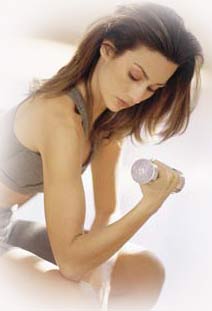 “I’m not seeing results, what gives?”
“I’m not seeing results, what gives?”
Another very common fitness myth is the idea that using high reps with light weights is best for building and toning long lean muscles while using low reps and/or heavy weights builds bulky muscles.
All weight training provides relatively the same stimulus to your body whether you are looking to tone your muscles or build huge bulky muscles.
Whether your muscles become toned or bulky depends primarily on the caloric balance of your diet.
Anyone can use both high reps/low weight, and low reps/heavy weight to accomplish muscle toning or muscle bulking in a training program, diet causes the body to respond to the stimulus accordingly.
How This Myth Got Started
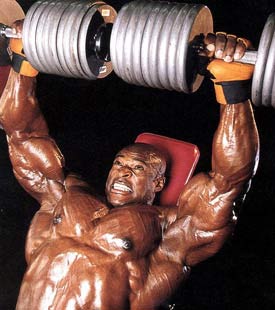 Fitness in the media including magazines, TV shows, advertisements often portrays men lifting heavy weights while women are lifting very small weights.
Fitness in the media including magazines, TV shows, advertisements often portrays men lifting heavy weights while women are lifting very small weights.
This has helped strengthen the myth because men (especially bodybuilders) lifting light weights, will even appear heavy to women which causes women to believe that performing 30 reps with a 0 pound dumbbell is the best way to tone up.
Further Reading: https://www.askthetrainer.com/what-is-muscle-tone/
#1. Spot Reduction
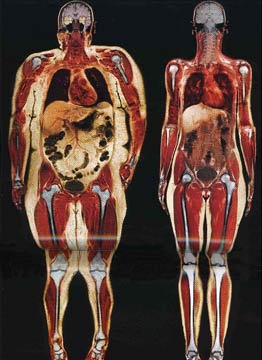 “Which exercises reduce my love handles?”
“Which exercises reduce my love handles?”
You can view the most common fitness myth of all time taking place at every gym across the world.
People performing exercises such as crunches, inner and outer thigh machines, triceps dips and the list goes on and on, with the hopes of burning the blubber which surrounds the muscle. It is simply not possible to target reduce fat.
Weight training is important for boosting and maintaining your metabolism but a caloric deficit from overall calories burned exceeding your caloric intake is what uses fat for energy.
Where the fat is reduced from your body is determined by your genetics and there is a very good chance your problem areas will be the very last place to show this fat reduction.
How This Myth Got Started
You can feel the contracting muscles working underneath the overlying fat. If scientific proof didn’t exist, the tightening and pump of the shortening muscles would feel to most everyone that fat is being burned when in fact the fat tissue has no clue to what is going on underneath.
Further Reading: https://www.askthetrainer.com/cat/weight-loss/
About Michael Behnken
Mike Behnken is a personal trainer who holds multiple NASM certifications and a MS in Exercise Science. Mike loves fitness, travel, and photography among many other interests.

